We take nine four-wheel-drive SUVs through three extreme tests to see how capable they are off-road.
If you’re wondering why you haven’t seen the Autocar India off-road day in five years, you’re not alone. We won’t lie, we have been tempted to do it every year since 2017, because there have been some great new contenders. The Jeep Compass Trailhawk, the new Thar and the Land Rover Defender, to name a few. This year, however, the stars – or should we say the rain clouds – aligned, and we got the squad together. Once the line-up was ready, we made a call to Dr Tejas Kothari who runs Learn Offroad Academy, to ask if we could visit his sprawling facility at Pali in Maharashtra, and if he wouldn’t mind curating a trail suitable for us to get stuck in and consequently unstuck from. The date was set, the plan was made, and, right on cue, it rained non-stop for 24 hours prior.
Off-road Day: the chosen ones
The one prerequisite for Off-road Day has always been four-wheel drive of some sort. So right off the bat, that meant no entry for popular SUVs like the Hyundai Creta and Kia Seltos, off-road modes notwithstanding, nor for the Tata Harrier and Safari, legendary SUV predecessors notwithstanding. Sorry, fanboys.
The next step of elimination was soft-roaders with no off-road pretensions. We would have really loved to include a Mahindra XUV700, for instance, but the brand is far better represented in the rough by the Thar and Scorpio. The VW Tiguan and Skoda Kodiaq, too; AWD they may be, but they do their best work on a smooth ribbon of tarmac.
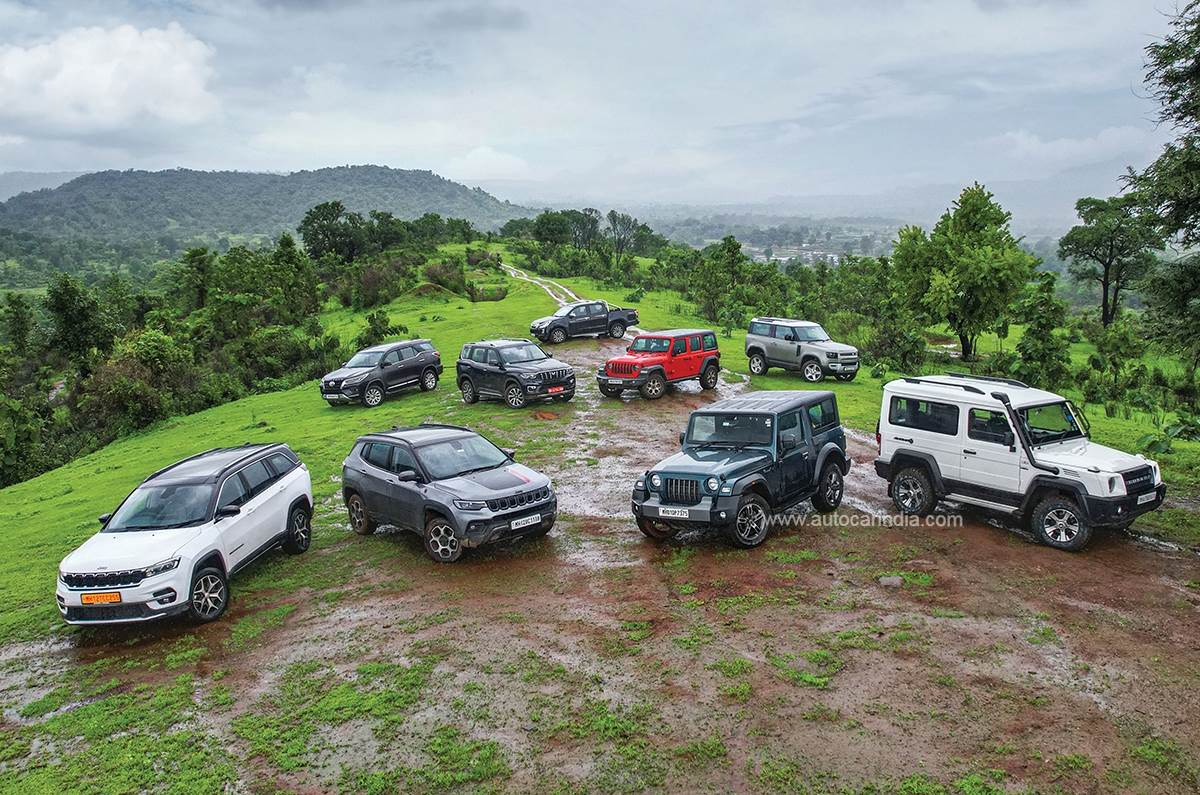
And finally, we did consider some of the fancier AWD EVs, like the Audi e-tron and Jaguar i-Pace, but again, we felt it would be purely academic; they aren’t meant for this, and not to mention their kerb weights that are on the unfavourable side of two tonnes.
So, which SUVs made the cut? This is probably the only group test where body-on-frame SUVs outnumbered the monocoque ones. Unbelievably, the two ‘softest’ off-roaders this year are Jeeps – the 7-seat Meridian and the Compass, this time in Trailhawk spec.
These are the only front-wheel-drive-based SUVs on the list, but that by no means is any reason to rule them out. The badge on their noses brings with it a pedigree that few others here can match (more so the Trailhawk), and it helps that they have terrain modes, 4WD lock and simulated low range.
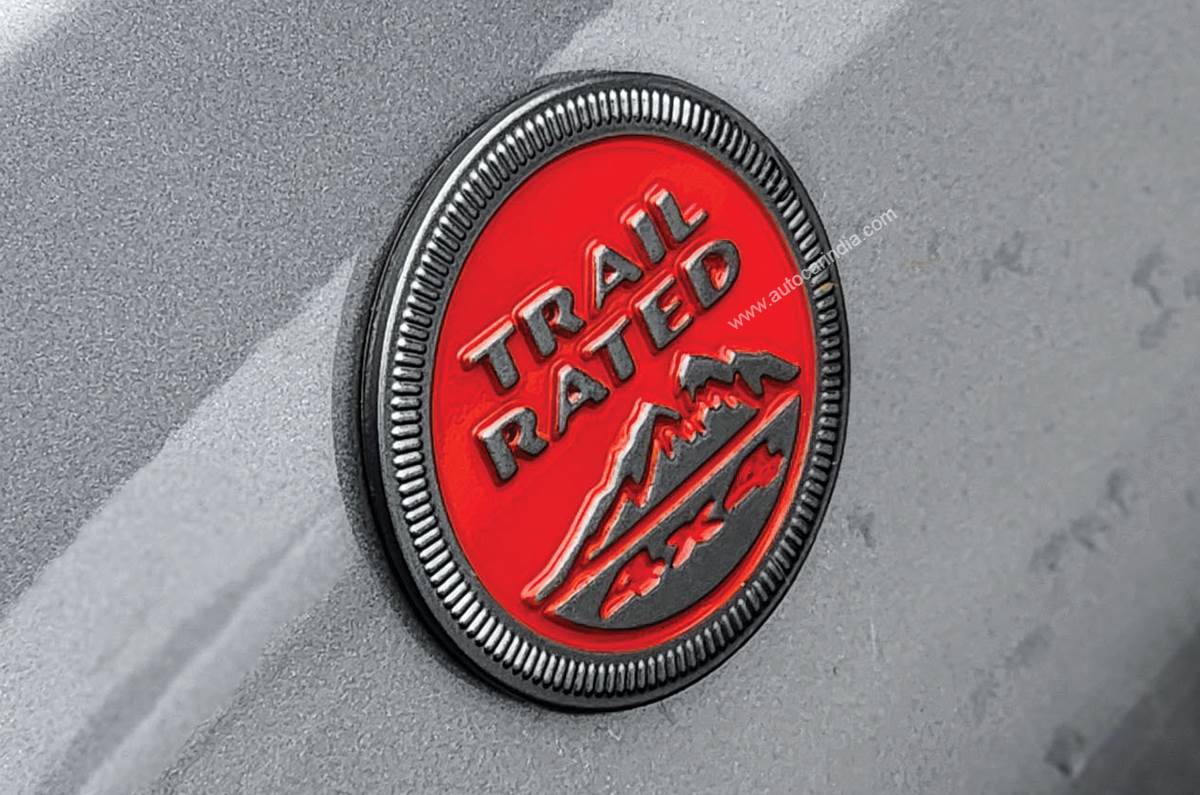
A returning favourite is the Isuzu D-Max V-Cross. So, why is it here again? For one, it has a different engine this time – a more compact, more powerful 1.9-litre turbo diesel – and secondly, because pickup trucks are just so damn cool, we had to have one. Incidentally, we were supposed to have two, but despite our best efforts, the mythical Toyota Hilux did not make an appearance. It’s perhaps the most basic vehicle here too, with 4×4, low range, a manual gearbox and not much else.
Grudge match time, and the first pairing is Thar vs Gurkha. In their second generations, the two have grown in opposite directions – the Mahindra padding itself up with more creature comforts for a wider appeal, and the Gurkha going even further in its quest for ultimate off-roader bragging rights. However, the team at Force Motors did send the car in with something of an unfair advantage – non-standard mud-terrain (M/T) tyres – which just on their own can significantly improve any vehicle’s off-road capability. And tyres, as you’ll no doubt see, will end up playing a huge role in today’s proceedings.
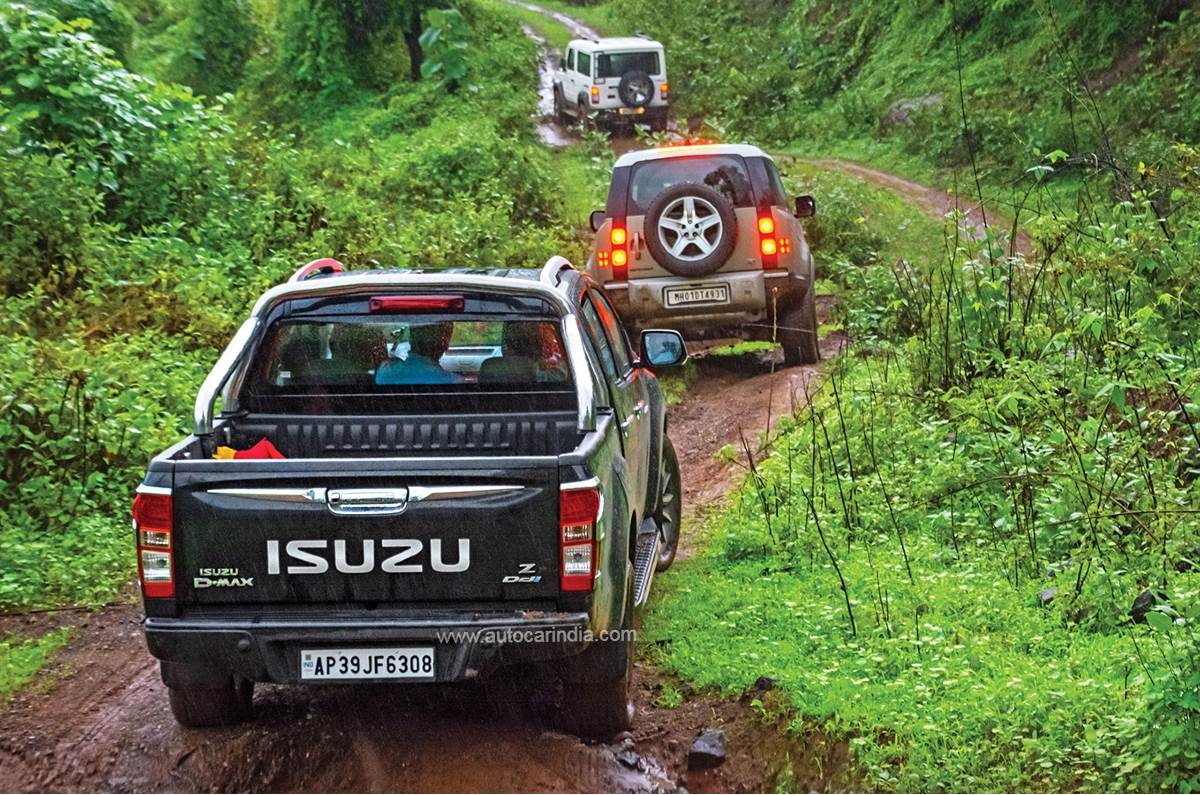
Next up, the newest SUV of this bunch, the Mahindra Scorpio N, under whose slick new veneer we found a surprising amount of old-school toughness when we drove it the first time. It’s got the bones of a Thar after all, and added to that is a set of terrain modes to better help it navigate the messy stuff. Now, Mahindra did say the Scorpio N would be going after D-segment SUVs, and since it has no direct rival, we brought back none other than the king of that segment, the Toyota Fortuner, which has been given a power and torque bump since 2017.
And finally, the elites; the absolute titans of off-roading – the Land Rover Defender and Jeep Wrangler – and here, much like the Thar and Gurkha, the approaches taken are radically different. The Defender, which we have in its ‘compact’ 90 spec, is a tech fest of aluminium-intensive construction, adaptive air suspension and clever software. The Wrangler, meanwhile, is the Rubicon variant, which means M/T tyres as standard, removable doors and anti-roll bars that can be decoupled for better articulation!
So, like we said, no softies here, and that’s just as well, because Tejas doesn’t look like he wants to go easy on us today.
Off-road Day: the articulation test
The first obstacle is simply entering the Learn Offroad facility, as the nasty weather has created a big rut right in the middle of the only approach path. A few of the SUVs show their first signs of trepidation, but it’s only a taste of what’s ahead. Before we start in earnest, tyre pressures are dropped considerably, to about 18psi, which widens the contact patch, increasing grip.
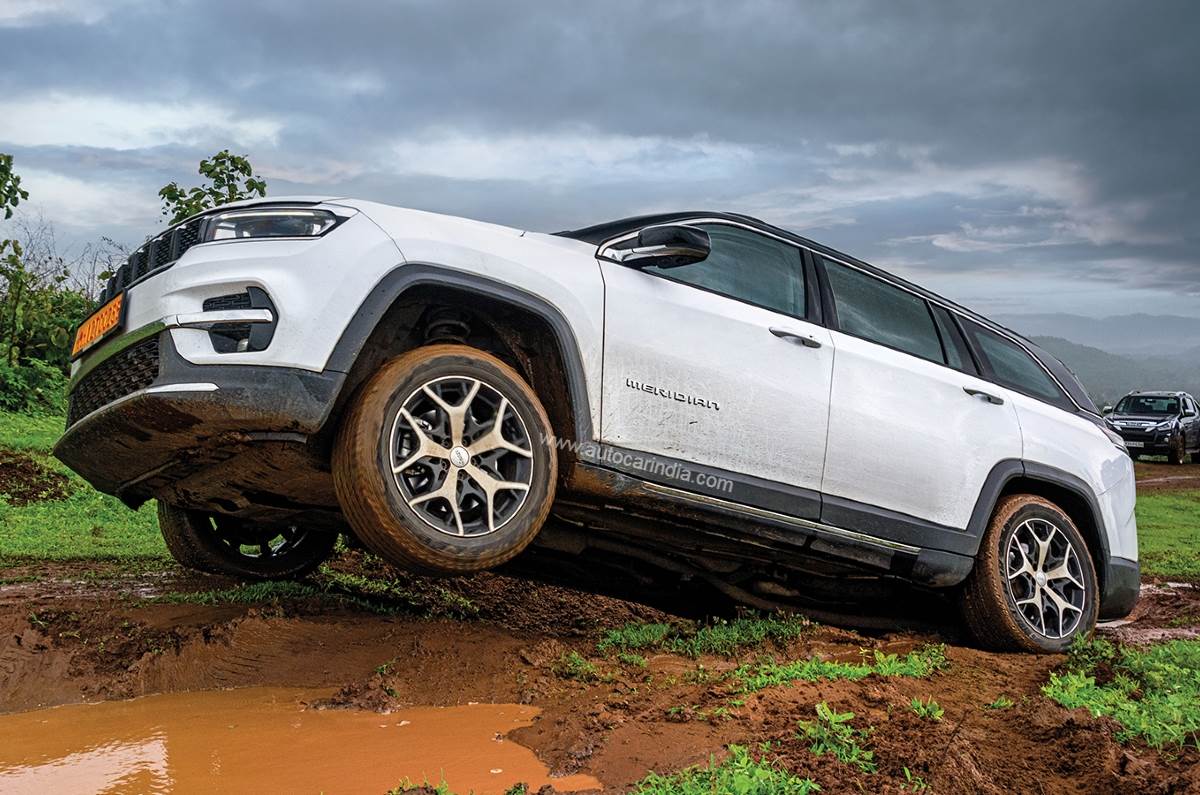
We’re told it’s an articulation test – a series of dips and mounds that causes your vehicle to see-saw – but all we can see from a few metres away is a small but deep pond. The rain has clearly taken its toll, and continues to, which means every car that passes through will wear down the trail a bit more for the next one. The front right wheel dips in first, flinging the left rear into the air, after which another mound is crossed, tipping the SUV in the opposite direction before it has to crawl up and out of the pit. Apart from just articulation, it’s also a test of an SUV’s consistency of power delivery, and right off the bat, it was a struggle.
Trailhawk’s trimmed bumper aids approach angle.
The Compass and Meridian, both needed multiple attempts to crack the very first test, and a lot of that was down to their reliance on electronics. Both were, of course, set to Mud mode, with 4WD Lock and low range, but the trouble here is that the Traction Control is, ironically, out of your control when using these modes. As a result, both Jeeps ended up cutting power at the crucial tipping point, in the middle of the see-saw, causing them to lose momentum and sink back in. The Meridian, with its longer wheelbase, even managed to snap sideways on the exit and beach itself on the mound.
The Isuzu’s length and lack of weight at the rear made it struggle in the first obstacle.
Ultimately it was momentum and a bit of roughhousing that got them through, and it was a similar story with the somewhat rudimentary Isuzu D-Max. Its immense length wasn’t so much an issue, but being a pickup truck, the lack of weight over the rear axle meant that it struggled to pull itself out at the end. We even had the crew hop into the flat bed for some ballast – sometimes the simplest solution is the best one. The manual gearbox and a bit of clutch slip also allowed for some better throttle control at just the right time.
Speaking of manual gearboxes, the Thar and Gurkha let you row your own ratios too, but thereafter, and given their similar positioning, there is a surprising disparity in how they feel. The cosier, comfier Mahindra wows you with its cool off-road graphics on the touchscreen, and as we dip into the obstacle, we can feel its rear mechanical locking differential engage automatically. It, surprisingly, takes two attempts to get through, however, and we’ll put that down to a set of somewhat worn-out all-terrain tyres on this car.
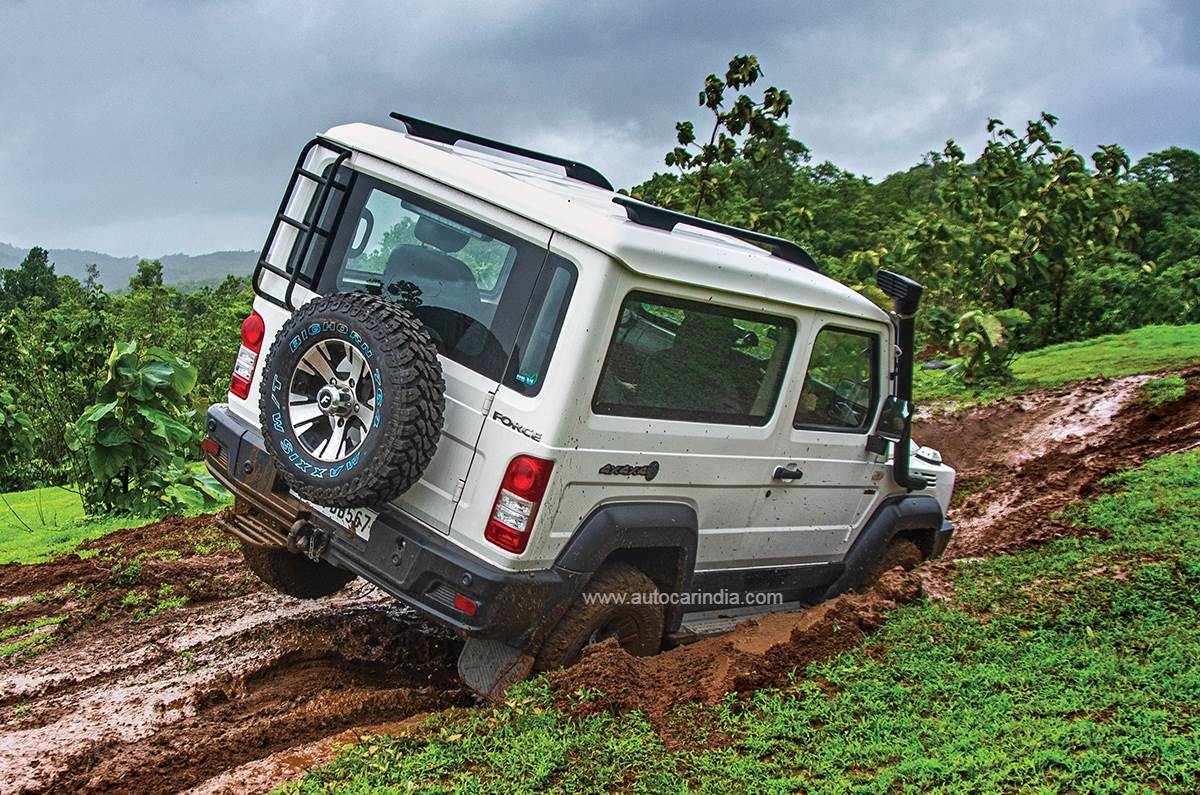
After spending more than a few minutes wrestling the Gurkha’s front and rear differentials into their ‘locked’ position and hammering it into 4 Low using the rudimentary levers, it was primed to go. Sat up high, it comes as quite a jolt when we tip the first wheel in, but still, we can’t help but notice wheel articulation is better than the Thar’s, as is the extra confidence the pre-locked differentials offer. The mud-terrain tyres do feel like a huge cheat code, though, as it’s clear, they make light work of the rapidly deteriorating terrain.
If you’re one of those that thought the Scorpio had gone soft in its new N avatar, you’ll be happy to know you’re wrong. It aced the first obstacle on its first go, with surprising ease and composure, and thanks to a newer set of tyres, had a better time of it than the more focused Thar. It feels like just the right blend of tough and sophisticated, which makes sense, because that’s always been the Fortuner’s remit too.

Again, we suspect, however, that tyres are what let the big Toyota down, as it too struggled to pull itself out of the obstacle at the end. Moreover, the new, electronically actuated locking rear differential just refused to engage on our car, hampering progress further; not quite the flawless Japanese reliability we’ve come to expect.
By the time we lined the tall, heavy Defender up for the pit, the track surface had deteriorated so badly that the car simply wouldn’t stay in one place; sliding gently down the hill with no driver input. Once on the move, though, the diff locks do their work, the electronics suss out the situation and the Land Rover confidently drops its air-sprung wheels into the water. There is momentary drama on the exit, just as the software figures out its next move and the tyres scrabble for grip, but nothing a Defender can’t overcome.
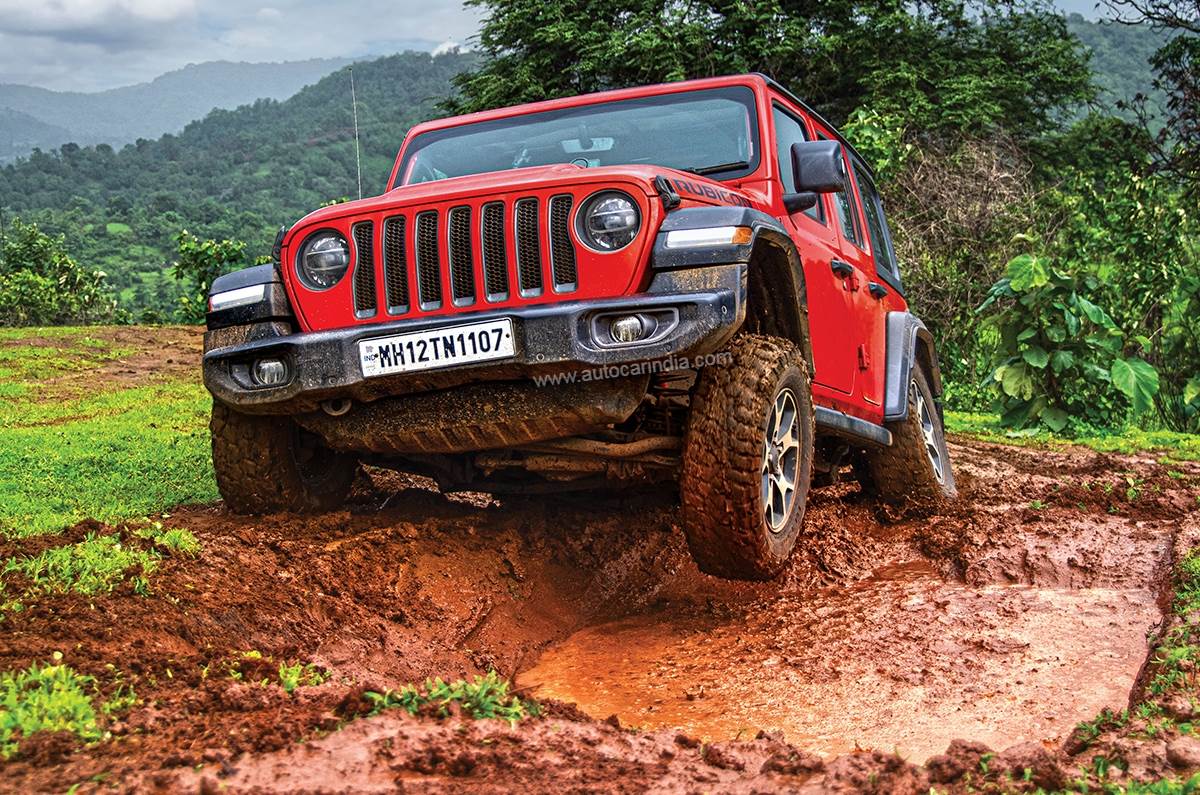
To say the Rubicon didn’t so much as flinch would be putting it mildly. We could have waded through slowly or quickly, maybe in reverse, and it wouldn’t have made a difference. Watching four wheels move so independently of one another has never looked so satisfying, and the M/T tyres cut through the mushy stuff with minimum churn and maximum grip.
Off-road Day: climbing out the rut
After the first obstacle proved surprisingly arduous for most of the vehicles, taking a walk to scope out the second comes as something of a relief. After all, how hard can driving in a straight line be, even if your vehicle is tilted at a 30-degree angle. Turns out, it’s not quite as easy as it seems. Shortly after putting wheels onto the angled surface, every SUV slams its passenger-side down hard into the embankment.
The Compass Trailhawk required two attempts to make it past Obstacle 2.
Thereon, it’s a mix of smoothness, momentum and gentle steering corrections to keep from getting stuck, and making it to the end of the approximately 100m ravine. The big challenge is at the end, where one has to take a near-90-degree right turn up and back out onto terra firma, avoiding taking out the left-side headlight on the far wall, and also testing the breakover angle while exiting the pit. Great.
The junior Jeeps, again, perform similarly to one another, crawling forward with acceptable composure down the angled track. It’s at the exit that both of them struggle to claw out, but surprisingly, it’s the longer Meridian that makes it out on its first go, after a bit of wriggling towards the end. Call it bad luck for the Compass Trailhawk, but it was the first to roll back into the pit and to require a second attempt, which, after some frantic scrabbling on the way out, it completed.
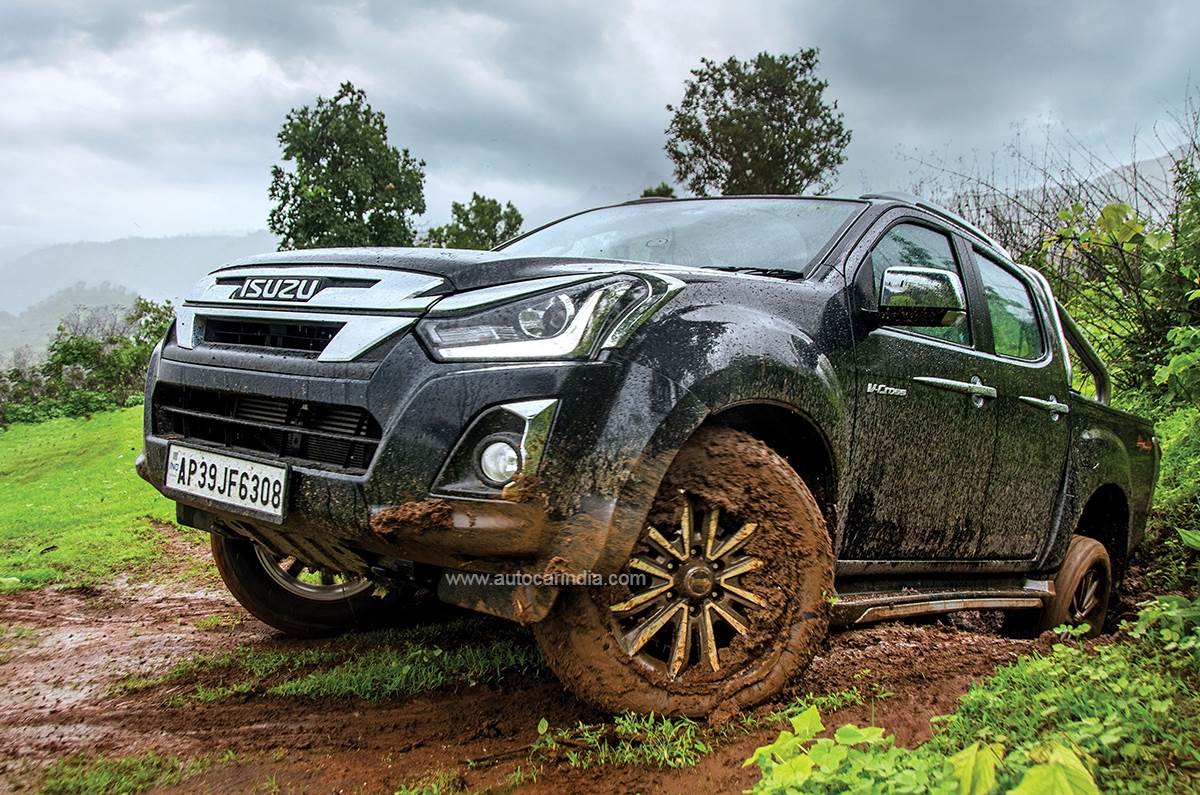
Tejas warns us that the Isuzu simply might not complete this obstacle at all, thanks to its all-too-basic set-up, and that we should probably just let it sit this one out. We disregarded his suggestion, of course, but we could soon see why he was wary. The exaggerated back-to-front weight imbalance meant holding the line wasn’t so easy, and once it slammed down into the ravine, pulling it back out wasn’t so easy. Though primarily a rear-driven vehicle, it relied far more on its front wheels to yank its lengthy body and bed out of the pit, and it was only after quite a struggle (and a small gash to its front bumper on the far wall) that it made it.
The Gurkha made light work of Obstacle 2 thanks to its mud-terrain tyres.
Perhaps the only difficulty we had in the Force Gurkha was some neck pain as we had to crane ourselves upright, while the tall, high-riding SUV leaned itself over into the obstacle. We felt the hard, heavy slam even more so in this hard, heavy vehicle, but there on it was unstoppable progress as usual.
The Thar made the entry and the inclined journey without much of a hitch, but was surprisingly frisky on the way out. We could put it down to the tyres again, but we suspect, again, that the momentary lapse before the mechanical rear diff kicks in is what caused the hesitation. The Scorpio N aced this obstacle too, and was really starting to prove to be the surprise performer of the show, but this time, the Fortuner held its ground as well.
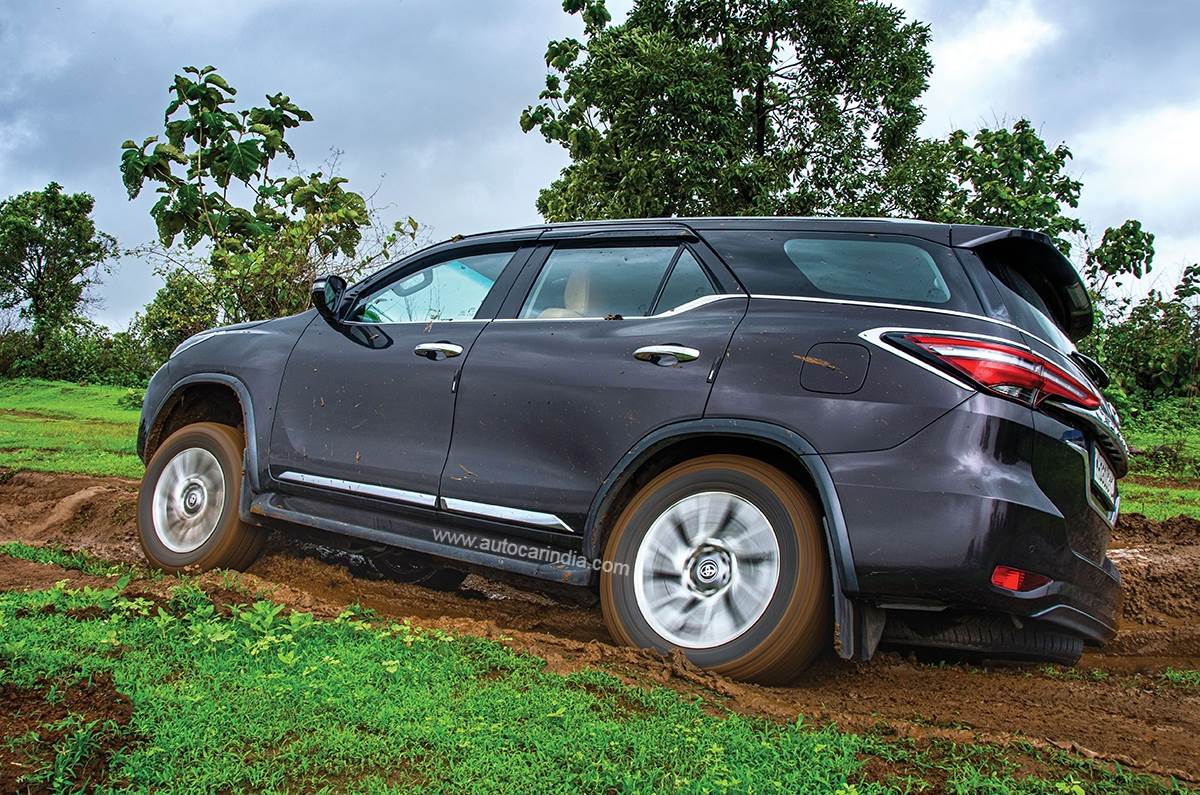
Both tall SUVs towered into the crevasse, slid into the wall early on and clambered their way up and out at the very end, on their first attempts. It was with great pomp and majesty, I’m told by those outside, that the Defender exited the trough.
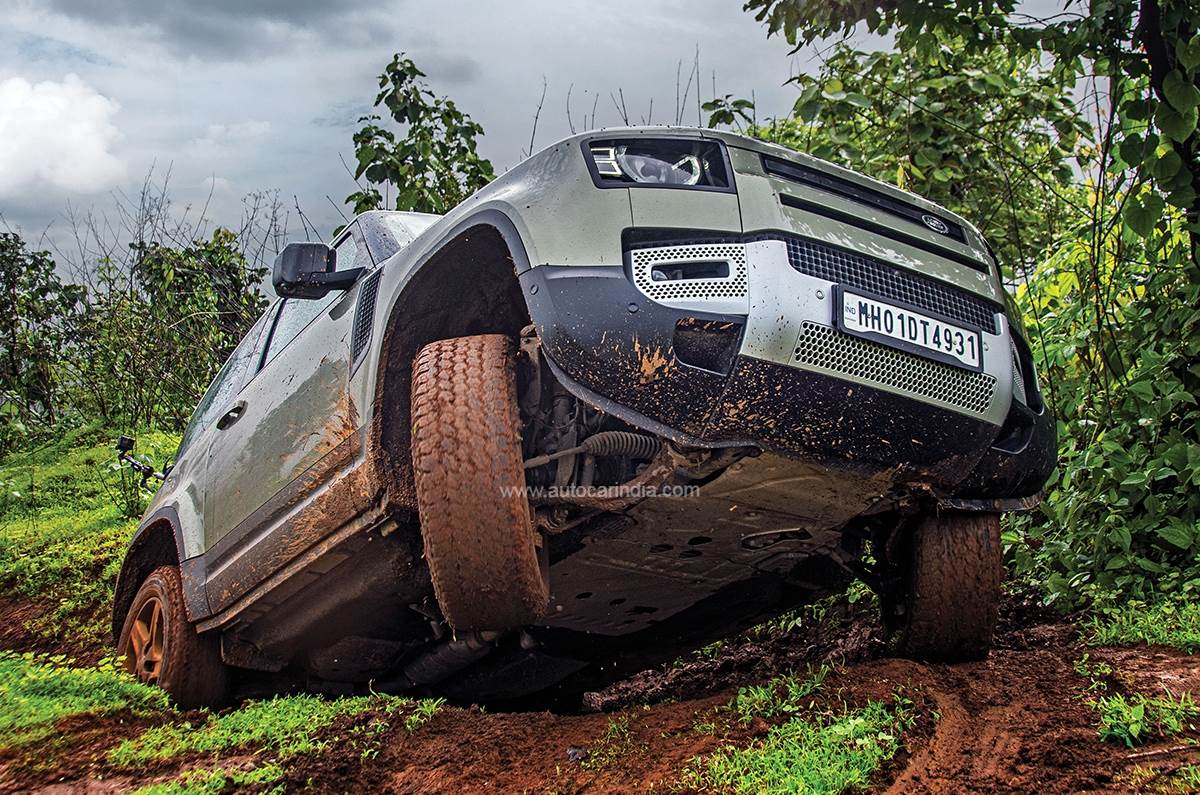
On the inside, things were so calm you could barely tell we were leaned over. The air suspension, of course, cannot level out an angle so steep, but you’d be surprised at what a difference it makes. In the Wrangler, just for fun, we decided to treat this ‘obstacle’ like just a casual straightaway and right-hander, at a pretty steady lick. It was as giggle-inducing as it was impressive the way it just shrugged it off.
Off-road Day: the hill climb
By this point the clouds were so heavy above, you could have sworn it wasn’t the middle of the afternoon. Any semblance of the track ahead had disappeared from sight, but Tejas assures us the last obstacle is just ahead, and very doable for our convoy of varying capability. And at first glance, it seemed he was right – ahead of us lay a short descent followed by a similarly short incline back up.
The Meridian’s low ground clearance made it quite tough to gain the required momentum.
But then, as we walked the soaking course, the steepness of both slopes became clear. This was a huge test of approach and departure angles, with huge ruts hidden away under flowing water to test clearance, and the cherry on top – a tree to avoid while cresting the hill at considerable speed.
In the Compass and Meridian, it was imperative that we took things easy. With the least ground clearance here, slipping into the ruts would mean an instant beach for either of them. At the base of the dip, it’s important – very much so in the Meridian – to not take the nose off while climbing up. Once clear, it’s imperative to build momentum fast to scale the hill, but sadly it’s not enough. Both Jeeps can’t muster enough speed to finish the course, and sadly, since time is running out, we have to retire them for now.
Brute force was the only way to ensure the Isuzu made it past the final course.
Not a good sign as we line up the D-Max next. We’re a little nervous about the long rear overhang, but the greater ground clearance allows us a little more liberty with the big trenches. After one failed attempt, we realise brute force is the answer for the Isuzu, and it makes it, but not without a struggle at the end to get the long pickup truck up and around the tree safely.
The Thar’s superior approach and departure angles really came into play here, allowing it to make it into the bowl and up out of it in one smooth movement. Even on its worn-out tyres, it scrabbled up the slope with little fuss, its best performance of all the obstacles. In the Gurkha, we chose the opposite approach – slow and steady; and why wouldn’t you, right?
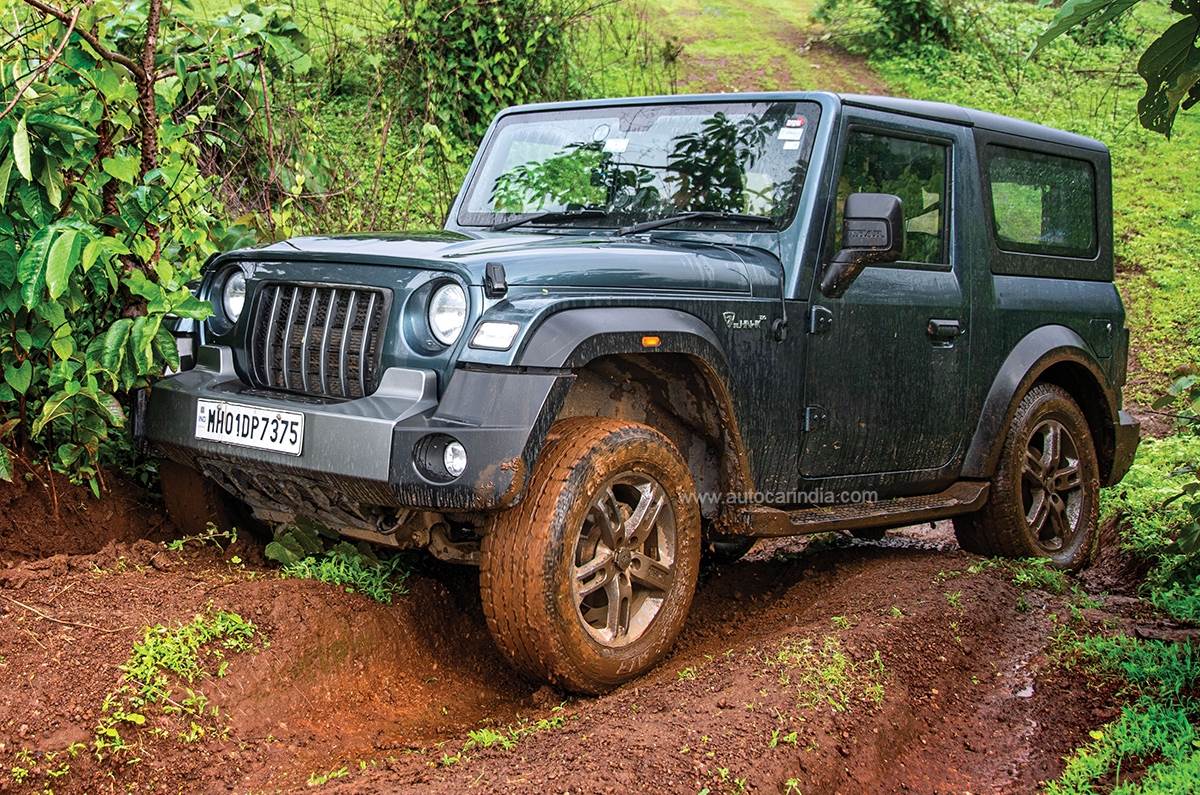
With its diff locks engaged, it prefers to tread slowly, and frankly we aimed for the ruts with this one. As the M/T tyres clawed it up the slope, we saw its first and perhaps only sign of hesitation all day, as its massive weight set it slightly off track. Some brief but harmless contact with the tree on the exit, and it was out!
It’s safe to say the Scorpio N won the day, going three for three, first try every time. Yes, it didn’t have things as easy as the Gurkha or even the Thar this time around, but its generous ground clearance and wide track gave us a lot of confidence to take it up the slope. Also helping was the diesel engine’s smoothy delivered slug of torque, whereas in the Fortuner, we had to almost temper our right foot to make sure we didn’t spin it all away too early.
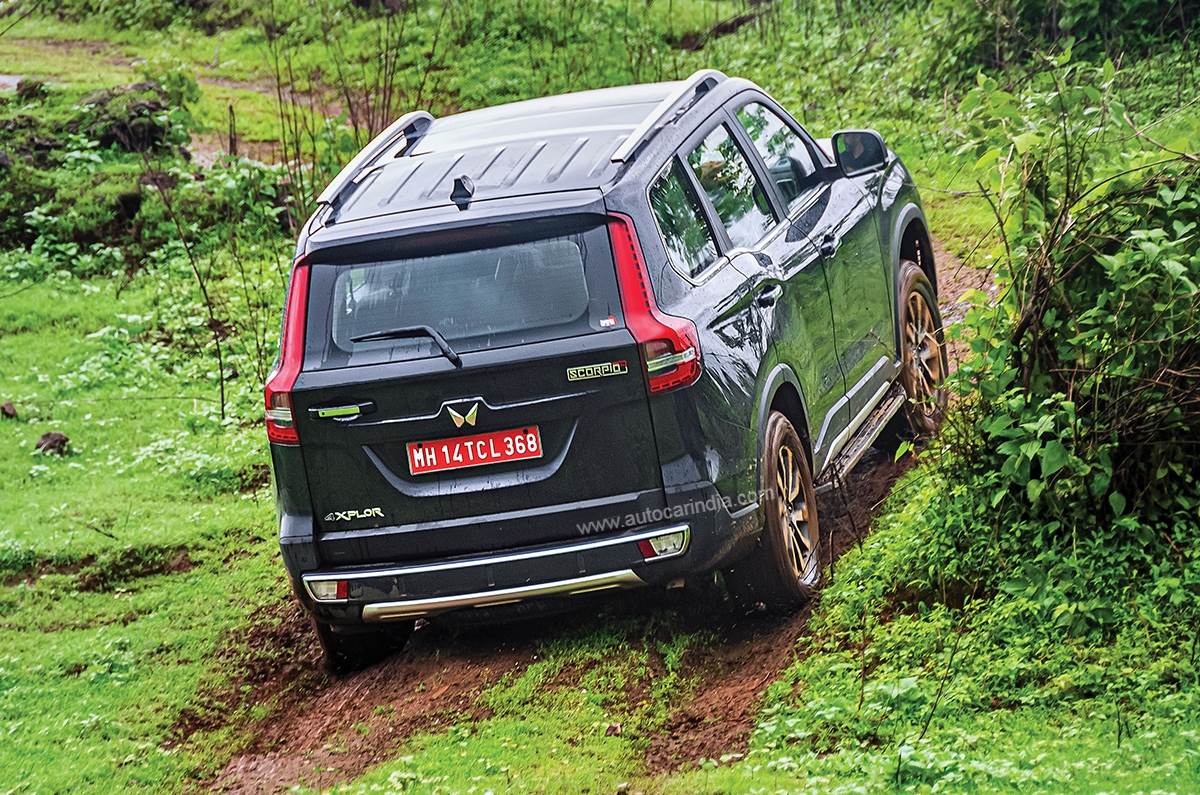
Yes, the 2.8 diesel with the auto gearbox serves up its 500Nm extremely low down, but once you get the knack for it, it’s very effective. Once again, the non-functional rear diff lock and worn tyres set it back a bit, but after a couple of attempts, it made it!
For the Defender, it was really weight and width that weren’t in its favour. The tyres were good enough but even though this is the ‘smaller’ 90, you’re constantly aware of the mass at work. Even after accidentally dropping a fat tyre into the big rut, it made it near to the top on the first go, but we backed out just as a precaution. We lined it up a bit better the second time, and with a bit more momentum, it got up and over in a flash, narrowly missing the tree. Phew!
The Wrangler Rubicon required little effort to clear all obstacles.
We thought this might be the first time the Wrangler would crack, but we were quickly proven wrong. Forget the existing ruts, the fat M/T tyres made a fresh set on their own, and before we’d even realised we’d started, the obstacle was already crossed. Almost comically easily, especially when you think how its younger siblings struggled. The Compass Trailhawk and Meridian, incidentally, were wrestled up and over at the very end of the day, ruts and a bit of belly scrape be damned.
Off-road Day: conclusion
Browned body panels, mud-caked wheels and tyres, and the odd tuft of grass picked up along the way are worn like badges of honour by all nine of our heroes. Tejas and his helpful team look happy to have put us and the vehicles through a proper challenge, though it’s fair to say the weather added its own difficulty multiplier.
Is there a ‘best SUV’ here? Sure, the Wrangler is all but unstoppable, and the Defender is the epitome of Land Rover’s ‘plush through the mush’ approach to off-roading. The Fortuner and Isuzu are old favourites with a tweak or two, the Gurkha remains one for the absolutely hardcore, while the Thar brings that original enthusiasm to a much bigger crowd.
| Prices and off-road specifications | |||||||||
|---|---|---|---|---|---|---|---|---|---|
| Parameters | Toyota Fortuner | Mahindra Scorpio N | Isuzu D-Max V-Cross | Jeep Wrangler Rubicon | Land Rover Defender 90 | Force Gurkha | Mahindra Thar | Jeep Compass Trailhawk | |
| Price (ex-showroom, Delhi) | Rs 40.83 lakh | Rs 21.90 lakh | Rs 23.50 lakh | Rs 61.35 lakh | Rs 87.89 lakh | Rs 14.75 lakh | Rs 14.49 lakh | Rs 31.32 lakh | |
| Approach/Departure angle | 29/25deg | 27.1/17.2deg | 30/22.4deg | 36/31deg | 37.5/40.0deg | 37/33deg | 41.8/36.8deg | 30/34deg | |
| Ramp breakover angle | 25deg | 20.1deg | 22deg | 21deg | 30.7deg | 25deg | 27deg | 24deg | |
| Max water wading depth | 700mm | 500mm | 500mm | 760mm at 8kph | 900mm | 700mm | 650mm | 480mm | |
| Diff lock | Yes | MLD, BLD | No | Front and rear | BLD | Front and rear | Rear MLD | No | |
| Low range | Yes | Yes | Yes | Yes | Yes | Yes | Yes | Yes | |
| Ground clearance | 220mm | 187mm | 225mm | 217mm | 216-290mm | 205mm | 226mm | 205mm | |
Swipe right to view the full table
The Meridian and Trailhawk, meanwhile, are perfect for the casual enthusiast who might need to tread over some rough ground occasionally. The unexpected wild card was definitely the Scorpio N, which has successfully made the transition to premium SUV while only building on its predecessor’s off-road capability.
But as Tejas tells us on the way back, Learn Offroad Academy sees applicants come in with all kinds of SUVs, and as long as they have 4×4, all are welcome. He explains that it’s more about how far one is willing to take their SUV that matters. Of course, not all cars are created equal, and as people get more serious about it, it’s easier to upgrade their existing vehicle than buy something more hardcore right away.
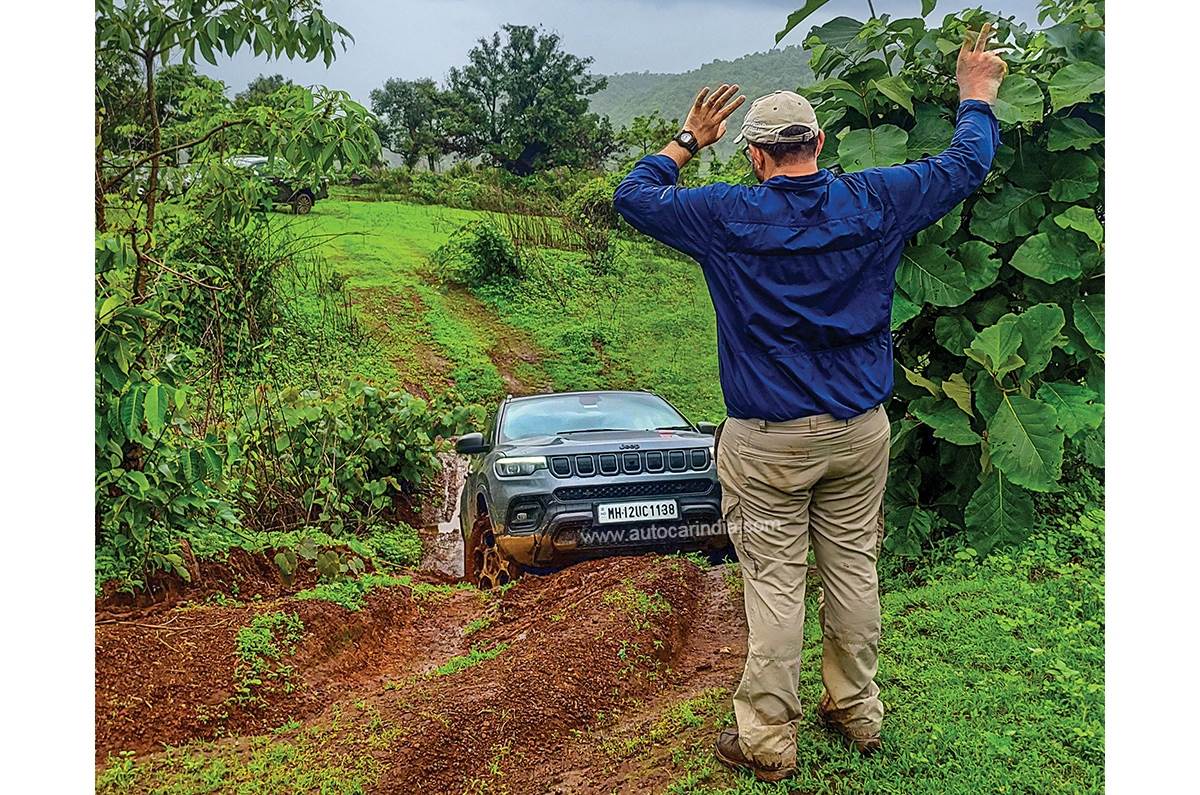
The first upgrade, he recommends, is a set of M/T tyres, and we saw what a difference that made to the Gurkha especially. The bottom line is this – recreational off-roading has never been easier to get into, not just because there are now tracks and academies to go to, but also because there are so many great 4WD SUVs on the market across a wide price range. So, yes, you don’t have to be an extremely technical off-roader to have a bit of fun in the mud on a rainy day, but boy is it fun when you do.
| Dimensions and powertrain details | |||||||||
|---|---|---|---|---|---|---|---|---|---|
| Parameters | Jeep Meridian | Jeep Compass Trailhawk | Isuzu D-Max V-Cross | Toyota Fortuner | Mahindra Scorpio N | Mahindra Thar | Force Gurkha | Land Rover Defender 90 | Jeep Wrangler Rubicon |
| Length | 4769mm | 4400mm | 5295mm | 4795mm | 4662mm | 3985mm | 4116mm | 4583mm | 4882mm |
| Width | 1859mm | 1818mm | 1860mm | 1855mm | 1917mm | 1855mm | 1812mm | 2105mm | 1894mm |
| Height | 1698mm | 1657mm | 1840mm | 1835mm | 1857mm | 1855mm | 2075mm | 1969mm | 1848mm |
| Wheelbase | 2782mm | 2636mm | 3095mm | 2745mm | 2750mm | 2450mm | 2400mm | 2587mm | 3008mm |
| Engine | 4 cyls, 1956cc, turbo-diesel | 4 cyls, 1656cc, turbo-diesel | 4 cyls, 1898cc, turbo-diesel | 4 cyls, 2755cc, turbo-diesel | 4cyls, 2198cc, turbo-diesel | 4 cyls, 2184cc turbo-diesel | 4 cyls, 2596cc, turbo-diesel | 4 cyls, 1997cc, turbo-petrol | 4 cyls, 1998cc, turbo-petrol |
| Gearbox | 9-speed automatic | 9-speed automatic | 6-speed manual | 6-speed automatic | 6-speed automatic | 6-speed manual | 5-speed manual | 8-speed automatic | 8-speed automatic |
| Power | 170hp at 3750rpm | 170hp at 3750rpm | 163hp at 3600rpm | 204hp at 3000-3400rpm | 175hp at 3500rpm | 130hp at 3750rpm | 91hp at 3200rpm | 300hp at 4000rpm | 268hp at 5150rpm |
| Torque | 350Nm at 1750-2500rpm | 350Nm at 1750-2500rpm | 360Nm at 2000-2500rpm | 500Nm at 1600-2800rpm | 400Nm at 1750-2750rpm | 300Nm at 1600-2800rpm | 250Nm at 1400-2400rpm | 400 Nm at 1500-4000 rpm | 400Nm at 3000rpm |
| Kerb weight | 1890kg | 1798kg (est) | 1955kg | 2180kg (est) | NA | 1774kg | 2175kg | NA | 2119kg (est) |
Swipe right to view the full table
Also see:
























